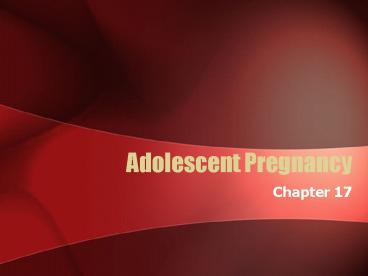Adolescent Pregnancy - PowerPoint PPT Presentation
1 / 23
Title:
Adolescent Pregnancy
Description:
Adolescent Pregnancy Chapter 17 Background Information Adolescent Pregnancy Major Health Issue in the United States One Million Teens Become Pregnant Each Year ... – PowerPoint PPT presentation
Number of Views:89
Avg rating:3.0/5.0
Title: Adolescent Pregnancy
1
Adolescent Pregnancy
- Chapter 17
2
Background InformationAdolescent Pregnancy
- Major Health Issue in the United States
- One Million Teens Become Pregnant Each Year
- Significant Costs to
- Mother
- Society
- Child
3
Factors that Contribute to Teenage Pregnancy
- Peer Pressure
- Lack of knowledge about sexuality and
contraception - Emotional Factors
- Socioeconomic Factors
4
Physical, Psychological, and Sociologic Risks
- Preterm Births
- Preeclampsia
- Iron deficient anemia
- CPD
- Drug and alcohol use
- STDs
- Interruption of development tasks
- Prolonged dependence on parents
- Lack of stable relationships with opposite sex
- Economic and social instability
5
Growth and Development Theories
- Adolescence Age 11 and up
- Piagets Periods of Cognitive Development
- Freuds Stages of Psychosexual Development
- Ericksons Stages of Psychosocial Development
- Kohlbergs Stages of Moral Development
6
Discussion
- Adolescent Pregnancy
7
Care Plan
- Adolescent Mother
8
Antepartal Nutrition
- Chapter 18
9
Ability to Achieve Proper Nutrition
- General nutrition prior to pregnancy
- maternal age
- maternal parity
- Prenatal Vitamins
- Start Early in Pregnancy
- Take at Bedtime/Nausea
- Flintstone Chewable
10
Food Safety
- Avoid swordfish, shark, king mackerel, and tile
fish- may contain potentially harmful levels of
mercury - avoid raw fish
- avoid undercooked meat, poultry, seafood, and hot
dogs - avoid deli meats-occasional cause of food
poisoning..bacteria found in ham, salami, and
bologna
11
Nutritional Needs of Pregnant Woman
- Calories
- fluids
- carbohydrates
- protein
- fat
- iron
- calcium
- Zinc
- Iodine
- Vitamins A D
- Folic Acid
12
Maternal Nutrition The Affect on Fetal Outcomes
- Research
- Folic Acid
- Drugs
- Alcohol
- Caffeine
- Smoking
13
Attainment of Maternal Roles
- Anticipatory Stage
- Formal Stage
- Informal Stage
- Personal Stage
14
Fetal Development Factors Influencing Embryonic
and Fetal Development
- Amniotic Fluid
- Placenta
- Fetal Circulation
- Quality of Sperm and Ovum
- Genetic Code
- Adequacy of Intrauterine Environment
- Teratogens
- First Three to Eight Weeks Are the most Dangerous
15
Figure 1111 Maternal side of placenta (Dirty
Duncan). SOURCE Photo courtesy of Marcia London.
16
Figure 1112 Fetal side of placenta (Shiny
Schultz). SOURCE Photo courtesy of Marcia London.
17
(No Transcript)
18
Fetal Development
- Week 4
- Week 6
- Week 12
- Week 16
- Week 20
- Week 24
- Week 28
- Week 32
- Week 36
- Week 38
19
Figure 1118 The embryo at 5 weeks. The embryo
has a marked C-shaped body and a rudimentary
tail. SOURCE Petit Format/Nestle/Science
Source/Photo Researchers, Inc., 60 East 56th
Street, New York, NY 10022, http//www.
photoresearchers.com, info_at_photoresearchers. com.
20
Figure 1120 The embryo at 8 weeks. Although
only 3 cm in CR length, the embryo clearly
resembles a human being. Facial features continue
to develop. SOURCE Petit Format/Nestle/Science
Source/Photo Researchers, Inc., 60 East 56th
Street, New York, NY 10022, http//www.photoresear
chers.com, info_at_photoresearchers.com.
21
Figure 1122 The fetus at 14 weeks. During this
period of rapid growth, the skin is so
transparent that blood vessels are visible
beneath it. More muscle tissue and body skeleton
have developed, which holds the fetus more erect.
SOURCE Used with permission from Nilsson, L.
(1990). A child is born. New York Dell
Publishing.
22
Figure 1123 The fetus at 20 weeks. The fetus
weighs approximately 435 to 465 g and measures
about 19 cm. Subcutaneous deposits of brown fat
make the skin less transparent. Woolly hair
covers the head, and nails have developed on the
fingers and toes. SOURCE Used with permission
from Nilsson, L. (1990). A child is born. New
York Dell Publishing.
23
Birth Defects
- Recently Been Linked to
- Individual Behavior
- Environmental Factors
- Rubella Syndrome
- Fetal Alcohol Syndrome
- Neural Tube Defects

